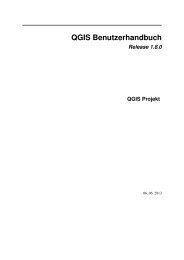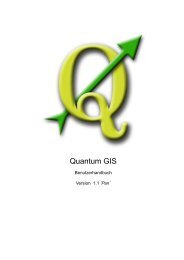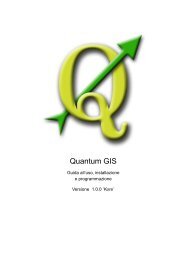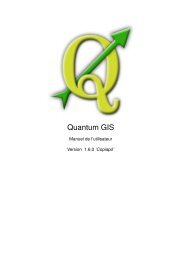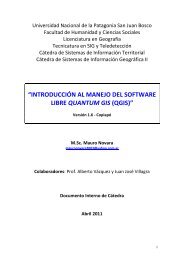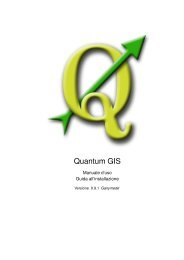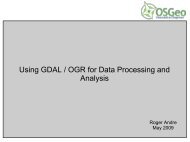QGIS User Guide - OSGeo Download Server
QGIS User Guide - OSGeo Download Server
QGIS User Guide - OSGeo Download Server
You also want an ePaper? Increase the reach of your titles
YUMPU automatically turns print PDFs into web optimized ePapers that Google loves.
12.14.6. Editing relations<br />
12.14 OpenStreetMap Plugin<br />
Thanks to existency of OSM relations we can join OSM features into groups and give them common<br />
properties - in such way we can model any possible map object: borders of a region (as group of<br />
ways and points), roads of a bus, etc. Each member of a relation has its specific role. There is a<br />
pretty good support for OSM Relations in our plugin. Let’s see how to examine, create, update or<br />
remove them.<br />
Examining relation<br />
If you want to see relation properties, first identify one of its members. After that open the Relations<br />
tab on the OSM Feature widget. At the top of the tab you can see a list of all relations the identified<br />
feature is part of. Please choose the one you want to examine and look at its information below. In<br />
the first table called ’Relation tags’ you find the properties of the selected relation. In the table called<br />
’Relation members’ you see brief information on the relation members. If you click on a member, the<br />
plugin will make a rubberband on it in the map.<br />
Relation creation<br />
There are 2 ways to create a relation:<br />
1. You can use the Create relation button on OSM Feature widget.<br />
2. You can create it from the Relation tab of OSM Feature widget using the Add relation<br />
button.<br />
In both cases a dialog will appear. For the second case, the feature that is currently identified is<br />
automatically considered to be the first relation member, so the dialog is prefilled a little. When<br />
creating a relation, please select its type first. You can select one of predefined relation types or write<br />
your own type. After that fill the relation tags and choose its members.<br />
If you have already selected a relation type, try using the Generate tags button. It will gene-<br />
rate typical tags to your relation type. Then you are expected to enter values to the keys. Choosing<br />
relation members can be done either by writing member identifiers, types and roles or using the<br />
identify tool and clicking on map.<br />
Finally when type, tags and members are chosen, the dialog can be submitted. In such case the<br />
plugin creates a new relation for you.<br />
<strong>QGIS</strong> 1.4.0 <strong>User</strong> <strong>Guide</strong> 195



